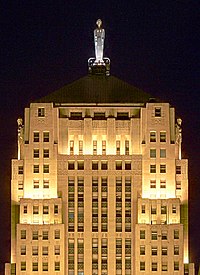Thalia Hall is a live music venue located in the Pilsen neighborhood of Chicago at 1807 S. Allport Street (at the corner of Allport and 18th Street). It is a legendary landmark built/commissioned in 1892 by saloonkeeper John Dusek and designed by architects Faber and Pagels. It hosts live performance events such as concerts and shows, as well as community activities. The building also houses retail and restaurant space.
It was built in the Romanesque Revival style and was designated a Chicago Landmark on October 25, 1989. The building was named for Thalia (Greek muse of comedy and poetry). The building was modeled after the Old Opera House in Prague, Czechoslovakia (where most of the Czech population in Pilsen had emigrated from). It was completed and opened to the public around the time of the opening of the World’s Columbian Exhibition. It is a very large commercial building. It cost $145,000 to build. That was alot for the 1800s (when most such buildings cost $50,000).
Thalia Hall became both a community gathering place and center for the arts. Community Centers (or Halls as they were called) were an important fixture in immigrant communities. It was a way for them to connect with people of their own nationalities in a big city that could be quite unfriendly at times. The residents had mostly manual labor jobs in factories, but enjoyed the arts, such as music and theater on the weekends and after work as recreation. Halls were also a place where labor union organizers often gathered to fight for labor issues such as an 8 hour workday, Sundays off and for saloons to be open on Sundays. Chicago Mayor Anton Cermak was once a saloonkeeper at Thalia Hall!
I was able to see Thalia Hall in person during a bus tour of Pilsen. When I saw it a wave of emotion came over me, because I was able to see this beautiful and historically significant building preserved so accurately and beautifully. It was a place I only read about in history, but since it has been preserved so well, I can see it as it looked in 1892 (when it was built)! ……………..Amazing, and the same is true of Pilsen itself!










*Note – The first two photos are my own. The rest are from Google.




















































































































